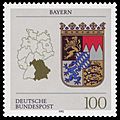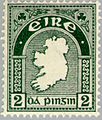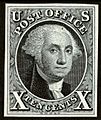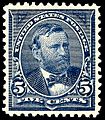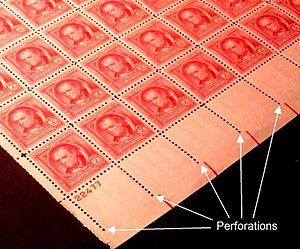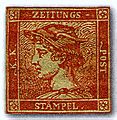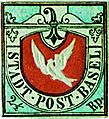Postage stamp facts for kids
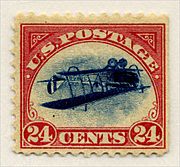
Postage stamps are pieces of paper, with glue or adhesive on the back. They are put on the corner of an envelope to pay the fee for having the postal service take the envelope to where it is being sent. There are a lot of different postage stamps in the world. They have existed since the nineteenth century. Most countries have their own stamps. People collect them in books called stamp albums. Sometimes people collect stamps from only one country, or there is something else that links the stamps. Perhaps, the stamps all have errors in the printing like in the "Inverted Jenny" picture with the aeroplane printed upside down.
Contents
Maps on stamps
Maps on stamps is a common topic on stamp collecting. Almost every country has featured maps on stamps. There are also topic maps including demographic and cross topic ones (showing explorer routes over maps).
- Examples of maps on stamps
-
Coat of Arms "Bayern" and Germany map
-
"Eire", 1922 Ireland
People on stamps
People on stamps is one more common topic in stamp collecting. For instance, many famous people are featured on stamps in the United States.
- Examples of people on U.S. stamps
History
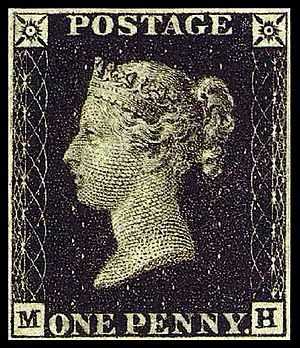
can be both a hobby and a form of historical study and reference, as government-issued postage stamps and their mailing systems have always been involved with the history of nations. --> Although a number of people laid claim to the concept of the postage stamp, it is well documented that stamps were first introduced in the United Kingdom of Great Britain and Ireland on 1 May 1840 as a part of postal reforms promoted by Sir Rowland Hill. With its introduction, the postage fee was paid by the sender and not the recipient, though it was still possible to send mail without prepaying. From when the first postage stamps were used, postmarks were applied to prevent the stamps being used again.
The first stamp, the "Penny black", became available for purchase 1 May 1840, to be valid as of 6 May 1840. Two days later, 8 May 1840, the Two penny blue was introduced. The Penny black was sufficient for a letter less than half an ounce to be sent anywhere within the UK. Both stamps included an engraving of the young Queen Victoria, without perforations, as the first stamps were separated from their sheets by cutting them with scissors.
The first stamps did not need to show the issuing country, so no country name was included on them. The UK remains the only country to omit its name on postage stamps, using the reigning monarch’s head as country identification. Following the introduction of the postage stamp in the UK, prepaid postage considerably increased the number of letters mailed. Before 1839, the number of letters sent in the UK was typically 76 million. By 1850 this increased five-fold to 350 million, continuing to grow rapidly until the end of the 20th century when newer methods of indicating the payment of postage reduced the use of stamps.
Other countries soon followed the UK with their own stamps. The Canton of Zürich in Switzerland issued the Zurich 4 and 6 rappen on 1 March 1843. Although the Penny black could be used to send a letter less than half an ounce anywhere within the UK, the Swiss did not initially adopt that system, instead continuing to calculate mail rates based on distance to be delivered. Brazil issued the Bull’s Eye stamp on 1 August 1843. Using the same printer used for the Penny black, Brazil opted for an abstract design instead of the portrait of Emperor Pedro II, so his image would not be disfigured by a postmark.
In 1845 some postmasters in the United States issued their own stamps, but it was not until 1847 that the first official U.S. stamps were issued: 5 and 10 cent issues depicting Benjamin Franklin and George Washington. A few other countries issued stamps in the late 1840s. The famous Mauritius "Post Office" stamps were issued by Mauritius in September 1847. Many others, such as India, started their use in the 1850s, and by the 1860s most countries issued stamps.
Perforation of postage stamps began in January 1854. The first officially perforated stamps were issued in February 1854. Stamps from Henry Archer's perforation trials were issued in the last few months of 1850; during the 1851 parliamentary session at the House of Commons of the United Kingdom; and finally in 1853/54 after the UK government paid Mr. Archer £4,000 for his machine and the patent.
Design
When the first postage stamps were issued in the 1840s, they followed an almost identical standard in shape, size and general subject matter. They were rectangular in shape. They bore the images of Queens, Presidents and other political figures. They also depicted the denomination of the postage-paid, and with the exception of the United Kingdom, depicted the name of the country from which issued. Nearly all early postage stamps depict images of national leaders only.
Soon after the introduction of the postage stamp, other subjects and designs began to appear. Some designs were welcome, others widely criticized. For example, in 1869, the U.S. Post Office broke tradition of depicting presidents or other famous historical figures, instead using other subjects including a train, and horse. (See: 1869 Pictorial Issue.) The change was greeted with general disapproval, and sometimes harsh criticism from the American public.
Perforations
Perforations are small holes made between individual postage stamps on a sheet of stamps, facilitating separation of a desired number of stamps. The resulting frame-like, rippled edge surrounding the separated stamp defines a characteristic meme for the appearance of a postage stamp.
In the first decade of postage stamps' existence (depending on the country), stamps were issued without perforations. Scissors or other cutting mechanisms were required to separate a desired number of stamps from a full sheet. If cutting tools were not used, individual stamps were torn off. This is evidenced by the ragged edges of surviving examples. Mechanically separating stamps from a sheet proved an inconvenience for postal clerks and businesses, both dealing with large numbers of individual stamps on a daily basis. By 1850, methods such as rouletting wheels were being devised in efforts of making stamp separation more convenient, and less time consuming.

The United Kingdom was the first country to issue postage stamps with perforations. The first machine specifically designed to perforate sheets of postage stamps was invented in London by Henry Archer, an Irish landowner and railroad man from Dublin, Ireland. The 1850 Penny Red was the first stamp to be perforated during trial course of Archer's perforating machine. After a period of trial and error and modifications of Archer's invention, new machines based on the principles pioneered by Archer were purchased and in 1854 the U.K. postal authorities started continuously issuing perforated postage stamps in the Penny Red and all subsequent designs.
In the U.S. the use of postage stamps caught on quickly and became more widespread when on March 3, 1851, the last day of its legislative session, Congress passed the Act of March 3, 1851 (An Act to reduce and modify the Rates of Postage in the United States). Similarly introduced on the last day of the Congressional session four years later, the Act of March 3, 1855 required the prepayment of postage on all mailings. Thereafter, postage stamp use in the U.S. quickly doubled, and by 1861 had quadrupled.
In 1856, under the direction of Postmaster General James Campbell, Toppan and Carpenter, (commissioned by the U.S. government to print U.S. postage stamps through the 1850s) purchased a rotary machine designed to separate stamps, patented in England in 1854 by William and Henry Bemrose, who were printers in Derby, England. The original machine cut slits into the paper rather than punching holes, but the machine was soon modified.
The first stamp issue to be officially perforated, the 3-cent George Washington, was issued by the U.S. Post Office on February 24, 1857. Between 1857 and 1861 all stamps originally issued between 1851 and 1856 were reissued with perforations. Initial capacity was insufficient to perforate all stamps printed, thus perforated issues used between February and July 1857 are scarce and quite valuable.
Related pages
Images for kids
-
The US Mail postage stamp of Marshal C. G. E. Mannerheim from 1961
-
The 1985 postage stamp for 115th birth anniversary of Vladimir Lenin. Portrait of Lenin (based on a 1900 photography of Y. Mebius in Moscow) with the Tampere Lenin Museum.
-
A Costa Rica Airmail stamp of 1937.
-
The Red Mercury, a rare 1856 newspaper stamp of Austria.
-
A 1987 Faroe Islands miniature sheet, in which the stamps form a part of a larger image.
See also
 In Spanish: Sello postal para niños
In Spanish: Sello postal para niños


